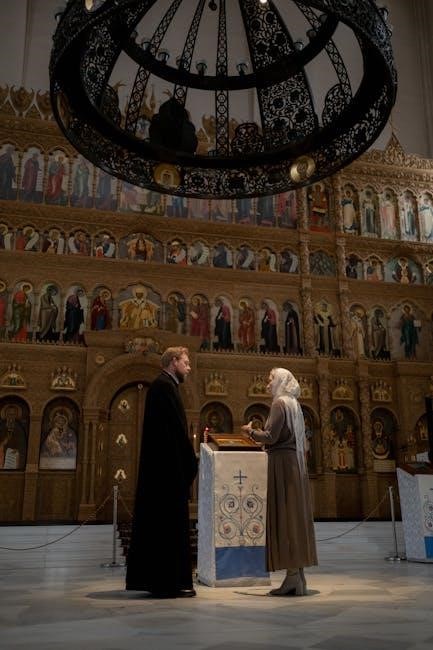The Litany of the Saints is a traditional Catholic prayer invoking the intercession of saints, martyrs, and angels. It begins with the Kyrie Eleison and includes petitions for mercy and guidance. This prayer is often used in liturgical contexts and spiritual exercises, emphasizing the communion of saints and the hierarchy of the Church. A Litany of the Saints PDF is widely available, providing a structured format for devotion and reflection.
1.1 Definition and Purpose
The Litany of the Saints is a sacred Catholic prayer that invokes the intercession of saints, martyrs, and angels. It is a structured devotion, beginning with the Kyrie Eleison and progressing through petitions for mercy and guidance. The litany serves to honor the communion of saints and seek their spiritual assistance. Its purpose is to deepen devotion, foster unity with the Church, and ask for divine intervention in personal and communal life. A Litany of the Saints PDF provides a convenient and accessible format for prayer and reflection.
1.2 Historical Context
The Litany of the Saints traces its roots to early Christian devotional practices, evolving over centuries into a formalized prayer; It reflects the Church’s tradition of invoking saints and martyrs for intercession. The litany gained prominence in medieval Europe and was later standardized in Catholic liturgy. Its historical significance is evident in its use during solemn occasions like the Conclave. A Litany of the Saints PDF often includes traditional chants and prayers, preserving its rich historical and spiritual heritage for modern devotion.
1.3 Significance in Catholic Prayer
The Litany of the Saints holds profound significance in Catholic prayer, emphasizing the Communion of Saints and their intercession. It strengthens faith, provides comfort, and fosters unity with the Church. The structured format, available in Litany of the Saints PDF, enhances accessibility for personal and communal worship. This prayer tradition is a timeless and essential resource for seeking divine mercy, guidance, and protection, deeply rooted in Catholic spirituality and practice.

History and Origins of the Litany
The Litany of the Saints traces its origins to early Christian prayer traditions, evolving over centuries. Its roots are in ancient liturgical practices, with the Litany of the Saints PDF preserving this rich spiritual heritage.
2.1 Early Christian Influences
The Litany of the Saints draws from early Christian practices, where believers invoked martyrs and saints for intercession. This tradition, reflected in the Litany of the Saints PDF, emphasizes communal prayer and devotion, mirroring the early Church’s reliance on the saints’ intercession for guidance and protection.
2.2 Evolution Over the Centuries
The Litany of the Saints has undergone significant evolution, reflecting the Church’s growth and devotional needs. Early versions were simple, while later expansions included more saints and martyrs. The inclusion of British saints, such as Martyrs of England, highlights regional adaptations. Over time, the litany has been refined to emphasize the communion of saints and their intercession. Its enduring structure, as seen in the Litany of the Saints PDF, ensures its relevance in contemporary prayer and liturgical practices.
2.3 Role in the Catholic Church
The Litany of the Saints holds a vital role in Catholic devotion, serving as a powerful prayer for invoking divine mercy and intercession. It is often recited during solemn occasions, such as the Conclave, and in liturgical ceremonies. The Church emphasizes its use in seeking spiritual guidance and protection. Available in Litany of the Saints PDF formats, it remains accessible for personal and communal prayer, fostering unity with the saints and martyrs. This prayer tradition underscores the Church’s belief in the communion of saints and their ongoing intercession.

Structure of the Litany of the Saints
The Litany of the Saints begins with the Kyrie Eleison, followed by invocations to the Blessed Mother, angels, saints, and martyrs, concluding with final prayers.
3.1 Kyrie Eleison and Initial Prayers
The Litany of the Saints begins with the Kyrie Eleison (“Lord, have mercy”), a solemn invocation for divine mercy. This is followed by initial prayers addressing God the Father, God the Son, and God the Holy Spirit, seeking forgiveness and grace. The structure, as seen in the Litany of the Saints PDF, emphasizes the Trinitarian nature of Christian prayer, establishing a tone of humility and devotion.
3.2 Invocation of the Blessed Mother
The Litany of the Saints honors the Blessed Virgin Mary with the prayer, “Holy Mary, Mother of God, pray for us.” This invocation seeks her intercession and maternal care. The Litany of the Saints PDF includes Mary’s title as Mother of the Church, reflecting her unique role in salvation history. This section emphasizes Marian devotion, aligning with Catholic teachings on her spiritual motherhood and her ability to intercede on behalf of the faithful.
3.3 Invocation of Angels and Archangels
The Litany of the Saints includes prayers to the Angels of God and specific archangels like Michael and Gabriel. This section seeks their divine protection and guidance. The Litany of the Saints PDF highlights their role as heavenly messengers and guardians, encouraging believers to invoke their aid in times of need. Their intercession is believed to provide strength and comfort, reflecting their importance in Catholic devotion and the broader spiritual hierarchy.
3.4 Invocation of Saints and Martyrs
The Litany of the Saints calls upon numerous saints and martyrs, including Peter, Paul, John, and Mary Magdalene. These holy figures are venerated for their unwavering faith and sacrifices. The Litany of the Saints PDF outlines their roles as intercessors, seeking their prayers for guidance and strength. This invocation emphasizes the communion of saints, uniting the faithful with the heavenly Church. It also honors the martyrs’ courage, inspiring believers to remain steadfast in their devotion and faith amidst challenges.
3.5 Conclusion and Final Prayers
The Litany of the Saints concludes with a heartfelt plea for divine mercy and protection. The final prayers often include petitions for the Church and its leaders, such as the pope and clergy. The Litany of the Saints PDF typically ends with a collective prayer, invoking God’s blessings and strength for all believers. This section serves as a spiritual culmination, reinforcing the unity of the faithful and their reliance on divine grace and the intercession of the saints.

The Role of Saints and Martyrs
The saints and martyrs in the Litany of the Saints are venerated for their holy lives and sacrifices. Their intercession is sought for guidance, protection, and strength, inspiring believers to emulate their virtues and remain steadfast in faith. The Litany honors their memory and invokes their aid, fostering a sense of unity and devotion among the faithful. Their examples are a testament to God’s grace and the power of perseverance.
4.1 Martyrs of England
The Martyrs of England hold a revered place in the Litany of the Saints, remembered for their unwavering faith and ultimate sacrifice. Many, like Saint Thomas Becket and Saint Margaret Clitherow, endured persecution during periods of religious turmoil. Their courage and devotion inspire believers to remain steadfast in their faith. The Litany honors their legacy, invoking their intercession for strength and guidance. Their stories, preserved in the Litany of the Saints PDF, serve as a testament to the power of faith and the enduring spirit of martyrdom.
4.2 Notable Saints in the Litany
The Litany of the Saints includes numerous notable saints whose intercession is sought. Prominent figures such as the Blessed Virgin Mary, Saint Joseph, Saint Peter, and Saint Paul are invoked for their divine assistance. Other notable saints like Saint John the Baptist, Saint Mary Magdalene, and Saint Stephen are also included. Their lives and martyrdom serve as inspiration for believers, reminding them of the power of faith and sacrifice. The Litany of the Saints PDF provides a comprehensive list, making it accessible for devotion and reflection.
4.3 The Significance of Their Intercession
The intercession of saints in the Litany of the Saints holds profound spiritual significance. It reflects the Catholic belief in the communion of saints, where the faithful on earth, in heaven, and in purgatory are united. By invoking saints, believers seek their divine assistance and protection, trusting in their proximity to God. This practice strengthens faith, provides solace, and embodies the Church’s teaching on the role of saints as models and intercessors. The Litany of the Saints PDF serves as a valuable resource for this devotion, fostering a deeper connection with the heavenly community.

Theological Significance
The Litany of the Saints reflects core Catholic doctrines, emphasizing the communion of saints, Mary’s role as Mother of God, and the Church’s hierarchical structure. It underscores divine mercy, intercession, and the unity of the faithful with heaven and earth, embodying the Church’s teachings on prayer and salvation.
5.1 The Communion of Saints
The Communion of Saints is a foundational doctrine expressed in the Litany of the Saints, uniting the faithful on earth, the saints in heaven, and the souls in purgatory. This prayer reflects the belief that all members of the Church, both living and deceased, are interconnected through Christ. By invoking the saints, the litany emphasizes their role as intercessors and models of holiness, fostering unity and spiritual solidarity among believers. It reinforces the Mystical Body of Christ, where the prayers of all contribute to the common good of the Church.
5.2 The Role of Mary, Mother of God
The Litany of the Saints prominently features Mary, Mother of God, invoking her intercession as the spiritual mother of all believers. Her title, “Holy Mary, Mother of God, pray for us,” reflects her unique role in salvation history. As the Queen of Saints, Mary is the first among all saints, emphasizing her maternal care and intercessory power. This devotion underscores the Catholic belief in her mediatorial role, seeking her assistance in uniting the faithful with Christ and fostering spiritual growth. Her prominence in the litany highlights her importance in Catholic theology and prayer life.
5.3 The Angels in the Litany
The Litany of the Saints includes invocations to the angels, recognizing their role as messengers and protectors. Archangels like Michael, Gabriel, and Raphael are specifically named, highlighting their divine missions. The litany also petitions the “Holy Angels of God,” seeking their guidance and protection. This reflects the Catholic belief in the angels’ intercession and their role as heavenly guardians. Their inclusion emphasizes the unity between the earthly and heavenly realms, appealing for their assistance in times of need and spiritual struggle. This practice strengthens devotion to their divine service and intercession.
5.4 The Hierarchy of the Church
The Litany of the Saints reflects the hierarchy of the Church by invoking prayers for the pope, cardinals, bishops, and clergy. It seeks divine guidance and protection for Church leaders, emphasizing their vital roles in maintaining the faith and guiding the flock. This practice underscores the importance of spiritual leadership and the unity within the Church’s structure, appealing for the strength and faithfulness of those who serve in these sacred ministries.

Spiritual Benefits of the Litany
The Litany of the Saints offers spiritual benefits such as receiving mercy, seeking forgiveness, and gaining guidance and protection. It fosters unity with the Church and strengthens faith.
6.1 Mercy and Forgiveness
The Litany of the Saints is a powerful prayer for seeking divine mercy and forgiveness. Its repetitive structure, with petitions like “Lord, have mercy” and “Christ, have mercy,” emphasizes the need for reconciliation. By invoking the saints, believers ask for intercession to obtain pardon for sins. The litany’s focus on God’s mercy aligns with Catholic teachings on redemption and spiritual renewal. This prayer, often included in the Litany of the Saints PDF, serves as a heartfelt plea for God’s compassion and grace.
6.2 Guidance and Protection
The Litany of the Saints offers a powerful means of seeking divine guidance and protection. By invoking the intercession of saints and angels, believers ask for direction in life’s challenges and safeguarding against spiritual and physical harm. The litany’s structured petitions, such as “Guide and protect Your holy Church,” reflect a deep trust in God’s providence. This prayer, often found in the Litany of the Saints PDF, fosters a sense of reliance on heavenly intercession for daily needs and eternal security.
6.3 Unity with the Church
The Litany of the Saints fosters unity with the Church by uniting believers in prayer, invoking the same intercessors and expressing shared faith. Its structured petitions create a sense of communal worship, whether recited individually or during liturgical celebrations. The repetition of “Pray for us” emphasizes the collective appeal for divine mercy. This unity extends beyond the earthly Church, connecting believers with the saints and martyrs in heaven, reinforcing the Communion of Saints. The Litany of the Saints PDF serves as a tool to strengthen this bond in personal and communal devotion.
6.4 Strength in Times of Trial
The Litany of the Saints offers solace and strength during challenging times, reminding believers of divine mercy and the intercession of holy figures. Its repetitive petitions create a soothing rhythm, fostering resilience and hope. Invoking saints who faced adversity inspires perseverance, while the prayer’s communal nature unites individuals in shared struggles. The Litany of the Saints PDF serves as a readily accessible resource, providing comfort and spiritual fortitude for those seeking divine aid in overcoming life’s trials.

Practical Use of the Litany
The Litany of the Saints is prayed during Mass, devotions, or personal reflection. Its structured format makes it accessible for communal or individual use, offering a meaningful way to seek divine intercession and spiritual growth through the invocation of saints and martyrs, as detailed in the Litany of the Saints PDF.
7.1 How to Pray the Litany
To pray the Litany of the Saints, begin with the Kyrie Eleison and respond to each invocation with “Lord, have mercy” or “Pray for us.” The leader recites the petitions, while the congregation responds. This call-and-response structure fosters unity and devotion. The Litany of the Saints PDF provides a clear, organized format, making it easy to follow and recite collectively or individually. Regular practice deepens spiritual connection and invokes the saints’ intercession for guidance and strength.
7.2 Occasions for Praying the Litany
The Litany of the Saints is appropriate for various occasions, including Advent, Lent, and during the Conclave. It is often prayed in times of crisis or need, seeking divine mercy and protection. The litany is also used in spiritual exercises, fostering reflection and devotion. Available in a Litany of the Saints PDF, this prayer can be easily accessed for personal or communal use, offering a structured way to invoke the intercession of saints and martyrs for guidance and strength in faith.
7.3 Use in Liturgical Contexts
The Litany of the Saints is integral to various liturgical celebrations, such as solemn processions, feast days of saints, and during the Conclave. It is often recited or sung in churches, emphasizing communal prayer and devotion. The structured format of the litany, available in a Litany of the Saints PDF, facilitates its use in Masses, benedictions, and other sacred rites. This ensures its accessibility and proper recitation, fostering unity and reverence among the faithful during liturgical events.
7.4 Role in Spiritual Exercises
The Litany of the Saints is a powerful tool in spiritual exercises, fostering meditation and reflection on the lives of holy men and women. It encourages seekers to invoke the intercession of saints for guidance and strength. Regular recitation of the litany, especially from a Litany of the Saints PDF, deepens devotion and enriches prayer life. It is often used in retreats, private devotion, and communal prayer, aiding individuals in their spiritual journey toward holiness and a closer union with God.

The Litany in Modern Context
The Litany of the Saints remains relevant in modern prayer, adapting to contemporary devotional practices. Its availability in PDF formats ensures accessibility for global Catholics, preserving its timeless appeal.
8.1 Relevance in Contemporary Prayer
The Litany of the Saints holds profound relevance in contemporary prayer, offering a structured yet flexible devotion. Its invocation of saints and martyrs resonates deeply, providing solace and guidance. The availability of a Litany of the Saints PDF has made it accessible to modern Catholics, enabling easy incorporation into personal and communal worship. This timeless prayer bridges tradition with modern spirituality, fostering a sense of unity and connection to the Church’s rich heritage.
8.2 Use in Devotional Practices
The Litany of the Saints is a powerful tool in devotional practices, offering a structured way to seek intercession and reflect on the lives of holy men and women. It is often recited during personal prayer, group devotions, or before significant events like the Conclave. The litany’s rhythmic format makes it ideal for meditation, fostering a deeper connection with the saints. A Litany of the Saints PDF provides easy access to this prayer, enabling believers to incorporate it into their daily spiritual routines and seek guidance from the communion of saints.
8.3 The Litany and the Conclave
The Litany of the Saints holds a significant role in the Conclave, the process of electing a new pope. Before entering the Sistine Chapel, cardinals sing the litany, invoking the intercession of saints and martyrs for guidance. This tradition reflects the Church’s belief in the communion of saints and their continued spiritual influence. The litany’s solemn tone and heartfelt petitions emphasize the gravity of the occasion, seeking divine wisdom and protection during this critical moment in the Church’s history.

8.4 Ecumenical Appeal
The Litany of the Saints transcends denominational boundaries, appealing to various Christian traditions. Its universal prayers and veneration of saints create a shared spiritual experience, fostering unity and mutual respect. The Litany of the Saints PDF is accessible to all, allowing diverse communities to engage with its rich traditions. This ecumenical appeal promotes a deeper understanding of the Church’s universal heritage, encouraging collaboration and prayer among Christians worldwide.

The Litany of the Saints PDF Resource
The Litany of the Saints PDF is a widely accessible resource containing the full text of the prayer, including invocations of saints, angels, and martyrs. It serves as a convenient and portable format for personal devotion, communal prayer, and liturgical use, preserving the rich tradition of invoking spiritual intercession in a modern, easily shareable document.
9.1 Availability and Accessibility
The Litany of the Saints PDF is readily available online, accessible through various Catholic websites and repositories. It can be easily downloaded or printed for personal or communal use. Many Catholic churches and organizations provide this resource free of charge, ensuring widespread accessibility. The digital format allows for effortless sharing via email or social media, making it a convenient tool for devotion. Websites like www.ourladyofbethesda.org offer this prayer in a downloadable format, catering to both individual and liturgical needs.
9.2 Contents of the PDF
The Litany of the Saints PDF typically includes the full text of the prayer, beginning with the Kyrie Eleison and progressing through invocations of the Blessed Mother, angels, saints, and martyrs. It often lists specific saints like Mary Magdalene, Stephen, and Perpetua, along with patriarchs, apostles, and notable figures. The document may also include introductory prayers, concluding blessings, and instructions for use in liturgical or devotional settings, ensuring a comprehensive and accessible format for spiritual practice.
9.3 Benefits of the Digital Format
The Litany of the Saints PDF offers enhanced accessibility, allowing users to pray anytime, anywhere, on various devices. It eliminates the need for physical storage, reducing clutter and ensuring the text is always readily available. Digital formats also enable easy sharing via email or social media, spreading devotion widely. Additionally, the PDF preserves the prayer’s integrity while offering searchability and zoom features for readability. This modern convenience aligns with today’s tech-savvy world, making spiritual practices more adaptable and inclusive for all.
9.4 Where to Find Reliable Sources
Reliable sources for the Litany of the Saints PDF include official Catholic websites, such as those of parishes, dioceses, and Vatican-affiliated platforms. Trusted repositories like EWTN and Catholic Culture also provide authentic versions. These sources ensure the text is accurate and faithful to tradition. Additionally, many Catholic publishers offer downloadable PDFs, guaranteeing quality and proper formatting. Always verify the source’s credibility to ensure the litany is free from errors and aligns with Catholic teachings.
The Litany of the Saints remains a powerful prayer, invoking divine mercy and intercession. Its timeless relevance is evident in its use across centuries and cultures, offering spiritual strength and unity. The availability of a Litany of the Saints PDF ensures accessibility for modern devotion, preserving tradition while adapting to contemporary needs. May this litany continue to inspire faith and guide believers in their spiritual journeys.
10.1 Summary of Key Points
The Litany of the Saints is a revered Catholic prayer invoking divine mercy and intercession. It reflects the communion of saints, emphasizing unity with the Church and spiritual strength. The litany’s structure includes Kyrie Eleison, invocations of the Blessed Mother, angels, and saints, concluding with final prayers. Its historical roots and evolution highlight its enduring significance. Available in PDF, the litany offers a practical, accessible format for modern devotion, preserving tradition while meeting contemporary needs. It remains a vital tool for spiritual growth and faith expression.
10.2 Encouragement to Use the Litany
Embrace the Litany of the Saints as a powerful prayer tool, fostering unity with the communion of saints and seeking divine intercession. Its structured format, available in PDF, makes it accessible for personal or communal devotion. Use it to deepen your faith, seek guidance, and find strength in times of trial. By invoking the saints, you connect with the Church’s rich tradition and experience spiritual renewal. Let the litany be a source of comfort, inspiration, and closeness to God in your daily life.
10.3 Final Blessing and Prayer
May the intercession of the saints and the grace of God fill your heart with peace and strength. Through the Litany of the Saints, may you find comfort and inspiration. Let this prayer guide you in times of need, reminding you of the communion of saints and the divine mercy. May God bless you and protect you, now and forevermore. Amen.